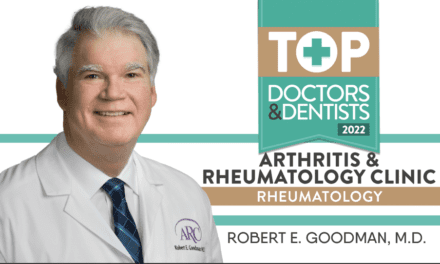BY DR. LINDSEY PENNINGTON
The world of cosmetic injections is rapidly growing year after year. As technology advances, it can be difficult to know the difference between a marketing ploy or fad, and what is truly an innovative advancement. With the growth of social media and the increase in general acceptance of noninvasive procedures, many patients are well versed; however, there are still large areas of information missed when scrolling through Instagram.
As a patient there should always be discussions about what your goals are with injections, the look you are going for, how subtle you would like results, and how long you would like them to last. It is so common for patients to be worried about looking “done” or overfilled. When performed correctly by a licensed trained cosmetic physician, after a physical exam, medical history, and full informed consent are obtained, results can be a great way to refine appearances in a very natural way.
Cosmetic injections are commonly thought to consist of neurotoxin and or filler. It is amazing what a good skincare regimen and a neurotoxin routine can do to help age delay the skin’s aging process.
Basics of Neurotoxins
 Botox Cosmetic is the original neurotoxin with the most studies done on safety over the longest periods of time. It works by blocking certain nerve signals that make muscles contract. When muscles can’t contract, the movement in the area treated stops, causing less lines and wrinkles in that area. Botox is best used to treat “dynamic” lines, those that happen when moving. If a line or wrinkle is there at rest, the best option for treatment will likely not be neurotoxin but filler instead.
Botox Cosmetic is the original neurotoxin with the most studies done on safety over the longest periods of time. It works by blocking certain nerve signals that make muscles contract. When muscles can’t contract, the movement in the area treated stops, causing less lines and wrinkles in that area. Botox is best used to treat “dynamic” lines, those that happen when moving. If a line or wrinkle is there at rest, the best option for treatment will likely not be neurotoxin but filler instead.
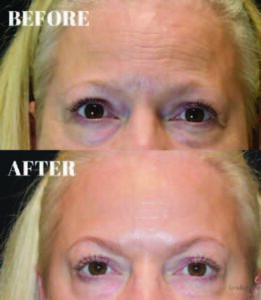 Botox usually takes about 4-7 days to start working and 2 weeks for full effect. Results can last on average 3-4 months. Botox has been on the market the longest, has been studied the most, and is very reliable. It can be placed very precisely in small muscles to get very specific results. In the hands of an expert injector this can make a very big difference!
Botox usually takes about 4-7 days to start working and 2 weeks for full effect. Results can last on average 3-4 months. Botox has been on the market the longest, has been studied the most, and is very reliable. It can be placed very precisely in small muscles to get very specific results. In the hands of an expert injector this can make a very big difference!
Other Neurotoxin Brand Options
Dysport is a neurotoxin like Botox that blocks specific nerve signals to prevent muscle contraction in the specific area that it is placed. Dysport usually starts working a little faster than Botox (about 48 hours) but can still take up to 2 weeks for full effect. Results last on average 3-4 months. A recent study showed some Dysport users who received treatment every 6 months were satisfied with the overall results and effect on anti-aging. If your goal is prevention more than the reversal of aging, treating with smaller amounts or treating less often is very reasonable. Dysport has a “greater area of effect” so when treating a larger area like the forehead, a smaller amount can be used to achieve a more cohesive result. Xeomin and Jeuveau are other neurotoxins on the market with slight differences in the specific proteins that make them up. Both tend to kick in a little faster like Dysport, but don’t seem to last quite as long. Duration tends to be about 2-2.5 months.
What’s New in Neurotoxins
A new neurotoxin coming to market early next year called Daxxify and is unique as it will last longer than any other toxin currently on the market: on average 6 months. Our own Dr. Skylar Souyoul, Board Certified Dermatologist, participated in the FDA clinical trial to get Daxxify approved. She knows firsthand what a game changer this product will be for patients who want to get longer lasting results from their established neurotoxin routine.
Basics of Filler
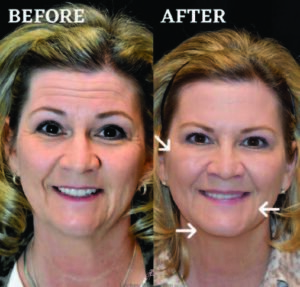 There are a wide range of options in fillers, which can be overwhelming. But it’s not your job to know what you need or where. It’s best to ask questions and discuss your areas of concern and make sure your physician injector has the same treatment goals as you. Fillers can be used in most areas on the face, most commonly in the nasolabial folds, cheeks, and lips, but can also be used in temples, jawline, chin, glabella, lateral brow, nose and more. Certain anatomical locations, such as the nose, are considered higher risk and should only be performed by an experienced advanced injector physician.
There are a wide range of options in fillers, which can be overwhelming. But it’s not your job to know what you need or where. It’s best to ask questions and discuss your areas of concern and make sure your physician injector has the same treatment goals as you. Fillers can be used in most areas on the face, most commonly in the nasolabial folds, cheeks, and lips, but can also be used in temples, jawline, chin, glabella, lateral brow, nose and more. Certain anatomical locations, such as the nose, are considered higher risk and should only be performed by an experienced advanced injector physician.
Hyaluronic Acid (HA) Fillers
HA fillers are the most known and asked about fillers. Brand names such as Juvederm and Restylane have been on the market the longest with the most safety studies performed. Other brands have come along in the last few years with Versa and RHA making the most headway. Hyaluronic acid is found naturally throughout the body with highest concentrations in joints, eyes, and skin. HA naturally attracts and retains water in the skin which helps the skin become more hydrated. As we age, the amount of HA we have decreases in addition to overall volume loss leading to fine lines, wrinkles, folds, along with appearing dehydrated and sallow. When HA is synthetically made in the form of dermal fillers it is temporary and will break down like natural hyaluronic acid in our bodies does. When injected it can help areas appear more hydrated, plump, while smoothing lines and wrinkles. They break down slowly over time and the area goes back to how it was before anything was injected. The fact that fillers are temporary is great, because it helps patients feel safe trying them and knowing that they aren’t committing to anything permanent. There is a chemical enzyme (Hyaluronidase) that can be used to quickly dissolve hyaluronic acid fillers in the case of a complication or unsatisfactory result. It is very important for your safety to make sure your physician has this enzyme in their office at the time of your injection.
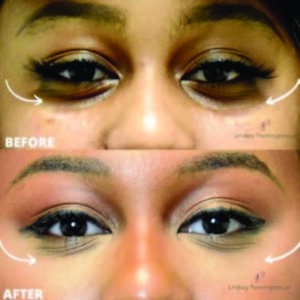 As fillers gain popularity, more people are trying to be involved in providing this service. It is key that the person injecting your filler is a board-certified core physician: a facial plastic surgeon, general plastic surgeon or dermatologist trained in cosmetics. These physicians undergo years of training that address anatomy, physiology and techniques that can ensure safe, consistent results. The Juvederm family of fillers includes Ultra, Ultra Plus, Vollure, Volbella, and Voluma (the longest lasting HA filler – 24 months). The difference among these is the firmness of the product, its affinity for water, and the longevity. What’s new: Volux, the first and only HA filler to receive FDA approval for improving jawline definition is set to be released this fall or early next year. As a trainer for Allergan, I will have first access to this product and I can’t wait to get my hands on it! The Restylane family of fillers includes Silk, Restylane, Lyft, Defyne, Refyne, and Kysse. The difference among these is firmness, cohesively (how well it sticks together when pressure applied), affinity for water, and longevity. What’s new: Contour, the only cheek filler with XpresHAn Technology™, restores your natural contour, frees dynamic expression, and refreshes your look. This is my favorite new product on the market. Traditionally cheek fillers have been firm to recreate the appearance of bone and structure to help lift the midface. Contour is softer and more dynamic, and the technology helps it move with dynamic facial expression and keeps natural looking facial expressions and smiles. Results last around 12 months.
As fillers gain popularity, more people are trying to be involved in providing this service. It is key that the person injecting your filler is a board-certified core physician: a facial plastic surgeon, general plastic surgeon or dermatologist trained in cosmetics. These physicians undergo years of training that address anatomy, physiology and techniques that can ensure safe, consistent results. The Juvederm family of fillers includes Ultra, Ultra Plus, Vollure, Volbella, and Voluma (the longest lasting HA filler – 24 months). The difference among these is the firmness of the product, its affinity for water, and the longevity. What’s new: Volux, the first and only HA filler to receive FDA approval for improving jawline definition is set to be released this fall or early next year. As a trainer for Allergan, I will have first access to this product and I can’t wait to get my hands on it! The Restylane family of fillers includes Silk, Restylane, Lyft, Defyne, Refyne, and Kysse. The difference among these is firmness, cohesively (how well it sticks together when pressure applied), affinity for water, and longevity. What’s new: Contour, the only cheek filler with XpresHAn Technology™, restores your natural contour, frees dynamic expression, and refreshes your look. This is my favorite new product on the market. Traditionally cheek fillers have been firm to recreate the appearance of bone and structure to help lift the midface. Contour is softer and more dynamic, and the technology helps it move with dynamic facial expression and keeps natural looking facial expressions and smiles. Results last around 12 months.
RHA: 1,2,3,4
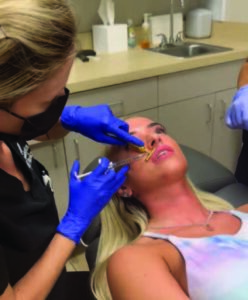 What’s new: RHA Redensity is the newest product on the market to treat perioral wrinkles (lip lines). As we age, we lose volume in our lips causing fine lines to set in around our mouth. This filler is specially designed to smooth and eliminate them. The results look natural and last up to a year. Pair this filler with microneedling with platelet rich plasma (PRP) and TNA+ Advanced Serum for improved results.
What’s new: RHA Redensity is the newest product on the market to treat perioral wrinkles (lip lines). As we age, we lose volume in our lips causing fine lines to set in around our mouth. This filler is specially designed to smooth and eliminate them. The results look natural and last up to a year. Pair this filler with microneedling with platelet rich plasma (PRP) and TNA+ Advanced Serum for improved results.
Non-HA Fillers Sculptra
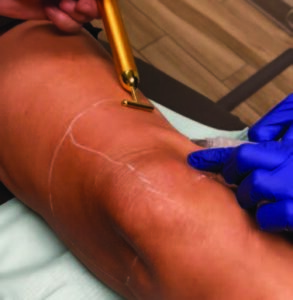 Poly-L-lactic acid is a biocompatible (safe to use in the body), biodegradable synthetic substance, which has been used for many years in medical devices, such as dissolvable stitches. Poly-L-lactic acid products are called biostimulants because they stimulate your own collagen production. Their main mechanism to smooth fine lines is by helping your skin rebuild its own natural collagen—the filler gel itself dissipates a few days after treatment, and then your body builds its own natural collagen over the next 6-12 weeks. Poly-L-lactic acid is typically used to treat deep facial wrinkles, and results can last more than 2 years. The effect is subtle and natural, helping with global facial rejuvenation while softening overall appearance. (I personally have Sculptra injected about once a year to help overcome the loss of collagen that happens yearly with aging.) Sculptra can also be used above the knees and the buttocks to decrease crepey skin and improve tone.
Poly-L-lactic acid is a biocompatible (safe to use in the body), biodegradable synthetic substance, which has been used for many years in medical devices, such as dissolvable stitches. Poly-L-lactic acid products are called biostimulants because they stimulate your own collagen production. Their main mechanism to smooth fine lines is by helping your skin rebuild its own natural collagen—the filler gel itself dissipates a few days after treatment, and then your body builds its own natural collagen over the next 6-12 weeks. Poly-L-lactic acid is typically used to treat deep facial wrinkles, and results can last more than 2 years. The effect is subtle and natural, helping with global facial rejuvenation while softening overall appearance. (I personally have Sculptra injected about once a year to help overcome the loss of collagen that happens yearly with aging.) Sculptra can also be used above the knees and the buttocks to decrease crepey skin and improve tone.
Radiesse
Calcium hydroxylapatite is a naturally occurring substance found primarily in our bones. When used in a filler, the calcium particles are nearly microscopic and suspended in a smooth gel. The consistency of a CaHA filler is typically thicker than that of a hyaluronic acid filler and typically lasts longer, about 12-24 months. CaHA is also reported to help stimulate natural collagen production as well. Radiesse injected in the jawline helps increase definition and smooth the skin. It gives instant results due to the gel consistency but lasts longer due to its biostimulatory effects.
Fat Injections
When patients are not getting the results they once did from injections or want something with less maintenance, autologous fat injections are a great option. Fat is harvested from elsewhere on the body, most commonly the abdomen or inner or outer thighs, via liposuction, and then processed and injected under sterile conditions into areas of your face. The fat is permanent and the injection has growth factor concentrations even higher than platelet rich plasma (PRP) and help to improve skin quality. It can take more than one session, but the results are long lasting. Overall, office injections are a great way to get quick, easy results that can help prevent, maintain or reverse signs of aging. It’s important to ask questions and have discussions with your physician to come up with your customized treatment plan to help you get the best results for your goals!





 Dr. Pennington is a double boardcertified facial plastic surgeon in Shreveport, LA. She is a national speaker and injection trainer for Allergan, the maker of Juvederm and Botox, as well as Galderma, the maker of Restylane and Dysport.
Dr. Pennington is a double boardcertified facial plastic surgeon in Shreveport, LA. She is a national speaker and injection trainer for Allergan, the maker of Juvederm and Botox, as well as Galderma, the maker of Restylane and Dysport.